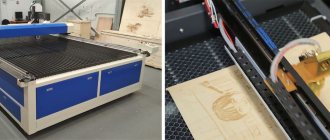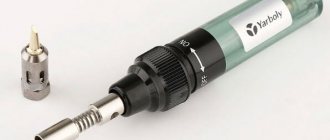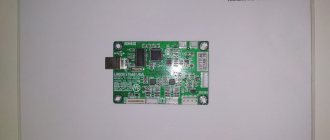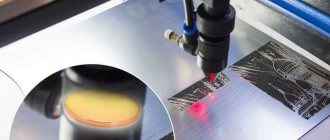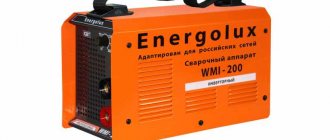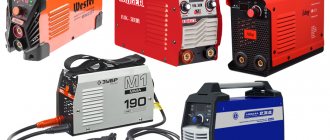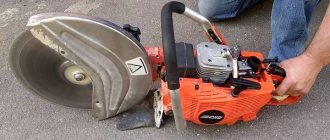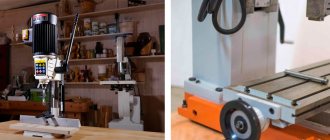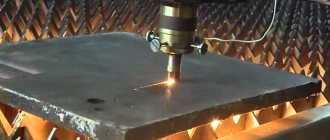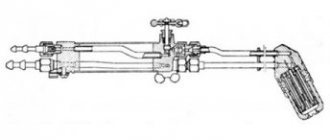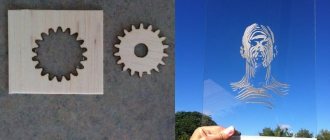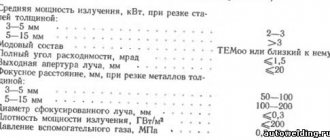The power of the laser module is a key parameter when choosing a machine for cutting plywood. But this is not the only factor that must be taken into account before purchasing a machine to solve specific problems.
Read our instructions for selecting CNC laser machines for cutting plywood.
What kind of laser is needed for cutting plywood?
The choice of a laser for cutting plywood directly depends on the tasks to be solved using the device.
To a first approximation, we can assume that the required power of the optical installation is directly dependent on the thickness of the plywood sheets being processed. In practice, there are other conditions that influence the selection of certain cutting machine parameters. For example, in a company that uses large circular saws to cut large sheets of plywood, a low-power laser machine may be the best option for cutting small sheets.
Laser machines for cutting plywood have a number of advantages that distinguish them from machines for mechanical processing:
- High cutting precision;
- Ability to create objects of complex shapes;
- Ease of use;
- No noise or sawdust in the process.
All of the above advantages are possible due to the fact that in laser machines the working “tool” is a thin beam of light with high power. The beam burns through the plywood board, leaving a thin and narrow cut, like a surgical scalpel. Thanks to numerical program control, the machine is able to draw an ornament of any complexity. Therefore, the most suitable tool for creating decorative plywood elements is a CNC laser machine.
The disadvantages include the cost of the laser machine. This drawback only applies to powerful devices with a large working surface. The price of basic models is comparable to milling machines of a similar area. If you have sufficient competence, you can assemble a laser machine of any power with your own hands. The work will take a lot of time, but the financial savings will be significant.
Depending on the power and functionality, machines are divided into types. Since nowadays even budget models are equipped with CNC, we will not consider manually controlled machines as an option.
Source: top3dshop.ru
By purpose:
- A cutting and engraving machine is a low-power device designed for engraving on plywood and cutting thin sheets;
- The industrial machine is a universal machine that is suitable for cutting plywood sheets of any thickness.
By laser head power:
- Up to 50 W - low-power devices;
- From 50 to 90 W - universal devices;
- From 100 W - industrial-grade devices.
There is a common relationship between the power of the laser machine and the size of the work area. Higher power means larger surface area to be processed. Exceptions happen very rarely.
Laser machines for plywood
In order to understand how to work with plywood correctly and why it is preferred to cheaper, pressed materials, you should first of all at least superficially study the technology of its production, understand how it is similar to other materials, and also realize that even plywood can be different! Yes, this is the cornerstone of the niche, because laser cutting of plywood using a CNC machine only from the outside looks like something very simple. In fact, as in any production, there are quite a lot of nuances that are mastered, as a rule, by gaining knowledge.
How plywood is glued together for laser cutting
If you have ever seen plywood from the end, then you probably already understand that a sheet of this material actually consists of several layers. If you think about it, you could already observe a similar production technology in the example of corrugated cardboard, which also consists of layers. This whole story visually resembles waffles, only using different types of wood and adhesive materials. So, depending on the types of glue used, plywood can be:
— based on urea-formaldehyde glue (or more simply, based on CF);
- based on phenol-formaldehyde glue (similar to FF).
These types of plywood differ primarily in the degree of adhesion and, most importantly, water resistance. Thus, plywood of the second type, based on phenol, is more moisture resistant and holds its shape better even when directly exposed to moisture. If you have already worked in the field of laser cutting of plywood, then you have probably used the first type of KF plywood and know firsthand that even with high air humidity, its sheets can warp, as a result of which the plane will be noticeably curved, and loading it into the machine will become uncomfortable .
And if you suddenly decided that all problems can be solved by using FF plywood, then we hasten to disappoint you. The phenolic compounds contained in the glue are extremely toxic and are used in everyday life except in the construction of non-residential premises, the design of an attic or porch. Those. in fact, it is not recommended to use this material in areas where people will interact with it consistently and closely. Especially when it comes to its constant heating and cooling, which inevitably happens with any building materials in a residential area.
Thus, it is probably not worth even clarifying that when burned, phenol will form toxic fumes, which will negatively affect the operator (the exception is working with the material in an isolated chamber with a powerful hood) and, as a result, it will not be possible to make large quantities from this material. some of the usual consumer goods. Of course, this does not stop many, because toppers are often made even from recycled, painted fiberboard and HDF. After all, it’s cheap and beautiful. But you must admit, few people want a piece of cake with phenol, no matter how beautiful this topper is. Moreover, the price of laser cutting of this type of plywood will be significantly higher than usual.
Also, you can find markings on the plywood with the scary letters “E”, which we often fear when we come across them in food products. Everything is much simpler here and this classification means:
— E1 – up to 10 grams of formaldehyde;
— E2 – from 10, but not more than 30 grams of formaldehyde;
Based on 100 grams of dry plywood. In other words, this is simply a classification of the concentration of formaldehyde in the adhesive solution and in practice it has little effect, since formaldehyde itself, although toxic, when burned, forms fairly light vapors that are easily removed with a regular hood and quickly dissipate in the air. Of course, if you breathe smoke exactly above the cutting head of the laser, then you can get your dose of poisons, but in practice such situations are close to absurdity and in our practice we have never encountered them.
Types of plywood for laser cutting
First of all, you should understand that plywood comes in different varieties. From beech, maple, ash, alder, linden and so on, ad infinitum, but most often you can find birch plywood. But much depends on the region of supply, the country and the prevalence of a particular type of wood, respectively. Thus, a special type of bamboo plywood is common in China. You might have encountered it if you bought Chinese plywood construction sets in stores. It is softer to the touch, lighter and more elastic.
Depending on the type of wood, plywood can be coniferous or hardwood. The main difference is that coniferous plywood is more moisture-resistant and, as a result, is more often used in construction and cladding, while hardwood plywood itself is denser and more elastic, due to which it can often be found in the production of furniture, toys, etc. .
You can also find a combined type of plywood, in which both coniferous and hardwood are used. As a rule, the outer layer of combined plywood consists of softwood, and the inner layer of hardwood. This allows you to optimize the cost, as well as get the best of both worlds, but frankly speaking, in traditional laser cutting of plywood, such a collaboration does not make much sense, since most of the products produced on a laser machine are not designed for a long life and are produced rather with with an emphasis on environmental friendliness rather than durability. Of course, if we are talking about making expensive souvenirs, this may make sense, but even such plywood products, after laser cutting, are sanded, stained, varnished, etc. As a result, there is simply no difference between what type of wood was used in plywood.
By the way, did you know that plywood for laser cutting is classified according to its outer layers? That is, if you buy beech plywood, it is quite possible that it has cheaper birch inside and this is normal. The fact is that the inner layers are laid in a special way, across the grain of the opposing wood, and this method, after gluing the layers, allows one to achieve the best strength. There are also situations in which it can be noticeable. For example, many have encountered the problem of internal knots. Even in the best varieties of plywood, this problem is present and nothing can be done about it. Also, if you had to glue two layers of plywood together, for example, 6mm, when you try to separate them, you are more likely to tear off the inner layers of the initial sheets than the area that you glued yourself. This, again, is due to the fact that the joining of outer layers of the same type can be much better than the inner one, but in practice you will encounter this extremely rarely.
Appearance and polishing. Why is it used for laser cutting?
Also, plywood can vary in appearance. Most often this applies specifically to external knots, cracks and other defects. So, you can find plywood of class E, that is, “Elite”, but this mythical beast is extremely rare, and its cost can discourage even avid plywood lovers. The most common are grades I, II and III of plywood for laser cutting. The first grade is also quite rare, and the third is used mainly for the production of products for subsequent painting or for the manufacture of baskets, pallets and boxes. The second grade is the most optimal, since there are practically no knots on the outer layers of plywood, and their number inside can also be ignored.
We can say that the main problem when laser cutting low-grade plywood is hidden knots. Since cutting through them requires much more power, and with multiple passes, they simply burn out and crumble, leaving behind unaesthetic burns and holes at the ends. Moreover, if standard 3mm plywood can be cut without problems with a 60W laser, then such a laser will simply stall on knots. That is why they often talk about comfortable work, which implies the use of high-power emitters. So, laser cutting of 3mm plywood with a laser up to 100W will allow you not to even think about internal knots, but you will remember about them again as soon as you try to cut through a thickness of 6mm and this is a given that you have to put up with.
A separate topic is grinding. Any plywood, of any grade, can be sanded or unsanded, respectively. At first glance, it may seem that the difference is purely cosmetic, because most of the products made on a laser machine are polished afterwards anyway. In fact, removing wood lint and carbon deposits from a finished product with sandpaper and sanding a sheet of pressed plywood are two very different things. In order to understand it, it is enough to encounter an unpolished type once and you are unlikely to want to repeat such an experience. Typically, such plywood is used not for laser cutting, but for milling or cutting with a jigsaw, with subsequent use for insertion into furniture or other structures where cosmetic factors do not play any role. This makes it possible to reduce the cost of production and, accordingly, increase the competitiveness of the enterprise.
Of course, large enterprises engaged in processing plywood using a whole series of different machines on the stream can simply purchase additional grinding equipment and carry out all the necessary work themselves, but the benefits of such operations are questionable. However, some manufacturers use, for example, thicknessers to more accurately position the thickness of the sheet and remove excess volumes, but again, such plywood processing methods should be considered rather atypical.
Optimal plywood thickness for laser cutting
In fact, the laser can handle almost any thickness, depending on the power of the emitter and the possibility of inserting the workpiece into the working field. In the last remark, the distance from the laser head nozzle to the work table plays a role. Since low-power machines, up to 80 W, are most widespread in our time, the lenses on them, as a rule, are short-focus. This means that the nozzle is practically adjacent to the material being processed and laying a workpiece of non-standard thickness will require the operator to lift the head, which also has its limits. This can be solved by installing a long-focus lens, which allows you to cut through thick materials more efficiently, but it is rational to install them only if the emitter power exceeds 100W.
But this is a theory, but in practice we can observe something like the following picture:
— Up to 70% of all plywood for laser cutting falls on thicknesses of 3 and 4 mm, respectively. This is due to the fact that it is this thickness that allows you to maximize the potential of a low- and medium-power laser machine, as well as produce products designed for a wide consumer, such as toys, construction sets, souvenirs, key rings, frames, and so on.
— About 20% falls on plywood from 6 to 12 mm - but it is important to understand that the price of laser cutting of plywood of such thickness is much higher due to the difference in speeds. So, if you can cut 3mm plywood with a laser at a speed of up to 30mm/sec without loss of quality and unnecessary deposits, then with 6mm the practical speed limit will be already 15mm/sec, and even then, if you have an emitter installed with a power in the range of 120 W, and 12mm at all – on average about 5mm/sec. Since all this takes up the working time of both the machine and the operator, the cost of the product increases proportionally. Consequently, it is not always rational to use laser machines for cutting plywood with a thickness of more than 4 mm.
— About 10% falls on other types of “non-standard” thicknesses, as well as cutting veneer, etc. The market does not experience a strict need for such products, therefore, as a rule, these are either narrowly targeted requests or the needs of the production itself for the purpose of self-sufficiency.
But what is the thickness of plywood and what is it formed from? Everything is very simple here. Since plywood for laser cutting consists of layers of veneer, and each layer is approximately 1 mm, you can calculate the approximate thickness of plywood by simply counting the number of layers. But here we should not forget about errors, both in the thickness of the veneer itself and in the volume of glue between the layers. Thus, if 3mm plywood in practice can be both 2.85 and 3.20mm, then in the case of 6mm plywood this spread can be even higher. The margin of error usually varies within one millimeter and this, by the way, is another argument in favor of sanded plywood. Since grinding allows you to remove the excess layer and thereby compensate for the error.
This is extremely important for laser processing, especially in prefabricated structures, for two reasons that you might not even think about when laser cutting plywood, for example, for flower shops or candy stores, where precision in the product does not play any role.
Firstly, a laser machine is an accurate, thin device that requires correct settings, and if a deviation within 0.05 mm can still be ignored, then every 0.1 mm error will affect the quality of beam focusing and, as a result, the cutting efficiency.
Secondly, when cutting prefabricated structures, it does not matter whether it is furniture or a game set, the planned grooves must exactly match each other in thickness and length. In this case, an exaggerated error can completely ruin the finished product.
In order to avoid such situations, anyone who decides to buy a laser machine to specifically engage in laser cutting of plywood is simply obliged to purchase a good caliper for measuring plywood at the stage of its delivery and subsequent sorting. By the way, many people neglect this stage, but based on personal experience we can say that the most effective production will be (specializing in the manufacture of small products), which devotes time to cutting sheets, sorting them by thickness, and then storing them under pressure.
Pressing plywood in production is another point that you come to only with time, because... It is impossible to predict how this or that batch of this material will behave under current conditions of temperature and humidity. That is why, after sorting, it is strongly recommended to place a number of weights on a stack of plywood, pressing it evenly to the floor. This will allow the sheets to be aligned during transportation, as well as to avoid deformation over time.
Laser cutting of plywood in practice
Now that you are well aware of what plywood is as a material and warned about the pitfalls, it’s time to pay a little attention to what areas is plywood used in general? After all, if buying a laser for cutting plywood is so profitable, then you have to deal with it all the time?
In fact, this is true, but as a rule, we do not notice this until we begin to produce the same products ourselves. Moreover, if just a couple of years ago this was not so common, now when you go to any store, you can notice a couple of plywood trays with pies or shawarma on the counter. The trays will naturally have the manufacturer's engraving on them. Flower shops are stocked with toppers and baskets, and cake makers use their plywood bases and racks on a regular basis. Even in chain supermarkets you can find lamps, toys, key rings or just decorations made of plywood in a wide variety of variations.
Thus, we can judge that laser cutting of plywood was, is and in the near future will be a popular area, since network giants rarely cooperate with anyone in areas for which there is no demand. Based on this, all you have to do is choose your own niche and produce exactly what will give you pleasure specifically. Plus, don’t forget about analytics! Explore your city or area. Talk to sellers and store owners and find out how many competitors you have and how often they buy plywood products. This is the first step towards forming your personal sales market, because a business built on laser cutting of plywood is based on close contact with selling points and it is unlikely that you will be able to sell a sufficient volume of products from your own counter. From the moment you decide to buy a laser machine for cutting plywood, you become a manufacturer and leave trade to those who deal with it.
Naturally, you will have to independently calculate the price of your products, because even buying plywood can sometimes be difficult, and finding a favorable price tag is doubly difficult, but the real problems begin when you have to explain these same price jumps to the consumer. Thus, we would recommend researching in advance not only the prices of laser cutting plywood, but also the cost of the final products. Very soon you will understand that the prices of even different suppliers are not very different from each other, since those who have been in the niche for a long time are quite good at calculating the average cost, taking into account the errors of fluctuations in prices for materials. In the first stages, this will make your life much easier and allow you to enter the niche without unnecessary problems, and so on until laser cutting of plywood begins to bring you both profit and pleasure!
What is a laser head for cutting plywood
Source: all3dp.com
A laser head for cutting plywood is an optical element of the machine, consisting of a radiation source (laser) and a focusing lens that directs the beam onto the surface being processed.
There are mainly two types of lasers used in plywood cutting machines:
- CO2 (carbon dioxide) - the source of radiation is a tube filled with gas. Such installations can have great power, but they have relatively large dimensions.
- Diodes - with a semiconductor laser - usually (but not always) have lower power, but very compact dimensions. Due to their compactness and ease of use, they are often used on small machines.
The best small format laser cutting machines
Equipment from this category is suitable for small spaces and is designed for small quantities of workpieces. It can be used to cut keychains, toys, logos and engrave gifts. This is an option for a related business (as one of the services provided, but not the main one) or for a hobby.
MCLaser 6040
Rating: 4.0
The leader in this category is also a machine from the MCLaser brand. It has a through zone for laser cutting with parameters of 60x40 cm. The kit includes both wide slats and a honeycomb surface for laying out small parts. The laser power is 90 W. The hardware works with RDWorks software, which has proven itself on industrial machines. Water cooling with chiller increases continuous operation time. You can configure the machine either via USB or via an Internet cable, which allows you to monitor the operation of the machine remotely, for example, from your office.
This is another machine, only among the small-format ones, which is capable of lowering the table up to 30 cm down in order to lay large workpieces. This functionality allows you to engrave not only flat objects, but also imprint the logo on the car rim.
Advantages
- circuit breaker on the body;
- additional three 220 V sockets;
- small honeycombs of the working surface;
- There are thick lamellas for through cutting of parts.
Flaws
- The height of the table is changed using a belt drive rather than a chain drive.
What is a laser module for cutting plywood
A laser module is a unit that consists of a laser head and other elements necessary for operation: an optical system, a power supply, a cooling system and control electronics. The implementation of a specific module circuit depends on the power and type of emitter, as well as on the purpose of the machine.
According to the purpose of the machine, laser modules are divided into:
- Collimated - to create a grating or circle with a laser beam;
- Focused - for consistent line formation.
Source: all3dp.com
In practice, as a rule, all laser modules for cutting plywood focus radiation at one point. Firstly, such a system is much cheaper and easier to maintain. Secondly, this way a CNC machine can form any lines. Therefore, focused modules allow you to cut out not only rectangles and circles, but also objects of arbitrary shape.
Laser modules are also divided into types, depending on the length of the light wave emitted by the emitter. In the case of plywood cutting machines, both diode and CO2 lasers belong to devices operating in the infrared range.
The best medium format laser cutting machines
Now let’s look at specific models that have already proven themselves among customers, having collected many reviews. A description with pros and cons will help you look at the product objectively and choose the most suitable one for yourself. The medium format category of machines is optimal for workshops and industries to produce products in large and medium-sized batches. The size of the working surface here varies from 60x90 to 150x250 cm.
MCLaser 1325V metal
Rating: 4.9
The list is topped by a portal-type machine with a working field size of 130x250 cm. The laser is generated using a carbon dioxide tube and reaches a power of 130 W, which is enough to cut plywood and other non-metals with a cross-section of up to 1.5 cm. Cutting steel is possible with a workpiece thickness of up to 2 mm. The positioning accuracy of the laser emitter is 0.01 mm. The manufacturer assures that the machine, namely the laser head, will last 8-12 thousand hours. It is allowed to operate the machine at temperatures of +15…+35 degrees. The laser drawing speed reaches 80 cm per second. The machine has its own control panel with a display and rubberized buttons, but it is possible to connect an external interface via LAN and USB connectors.
In addition to cutting, the machine is capable of engraving. Experts noted the minimum size of the applied element, which is an area of 1x1 mm. This gives high image clarity and allows you to transmit very detailed images. The engraving speed is 80 cm/s, which breaks all records for productivity.
Advantages
- comfortable legs for leveling the position of the body;
- all electrical parts are reliably protected;
- monochrome display;
- relatively economical in current due to the power of 2.5 kW;
- rubberized control buttons.
Flaws
- powerful exhaust ventilation with a moving suction pipe is required;
- weighs 570 kg, so installation is allowed only on a solid base;
- connection to a three-phase network;
- manual drive to raise the work table to a different height.
Rabbit HX-1525 FlatBed
Rating: 4.8
The second place is occupied by the largest representative of medium-sized machines with a cutting area of 150x250 cm, but it costs a little more affordable than its analogues. Here, too, the laser is generated by a Yongli R7 carbon dioxide tube with a power of 140 W. The cutting head is moved by a two-phase stepper motor. To set tasks, a Leetro MPC6525A control system is provided. The remote control is equipped with a display and large buttons. The machine laser cuts through plywood with a thickness of up to 12 mm, and plastic - 15 mm. Customer reviews like that the machine can be equipped with more powerful tubes if production needs require it. This will eliminate the need to buy a new cutting machine.
The machine was remembered by experts for its low power consumption in relation to the generated cutting power. The device consumes only 1.2 kW per hour of operation. For the competitor described above, this figure is twice as high, and the operating laser power is even 10 W less. This will provide more modest electricity bills and will reduce the cost of production.
Advantages
- there are wheels on one edge of the machine that make it easier to turn a large structure;
- large screen for setting and monitoring tasks;
- suitable for multi-batch production;
- sophisticated water cooling system.
Flaws
- large table slats through which small cut-out parts fall through;
- The tube's service life of 7,500 hours is inferior to that of other models.
Description of laser for cutting plywood
Source: all3dp.com
The operating principle of a laser plywood cutting machine is easy to understand: a laser emitter creates a beam of light of a given wavelength, and the beam power is sufficient to burn through the fibers of a wood board. The higher the power, the deeper the beam penetrates into the plywood, and the thicker the sheet that can be cut in one pass. The power range varies, starting from several watts.
What laser power is needed to cut plywood?
Source: all3dp.com
Typically, laser machines with the following emitter power are used for cutting plywood:
- Up to 50 W - for cutting sheets up to 6 mm thick;
- 60 - 80 W - for cutting sheets up to 8 mm thick;
- More than 80 W - for cutting sheets up to 10 mm thick.
The power of the emitter is always indicated in the device specifications, along with the power consumption of the device as a whole. For example, the LaserSolid 640 Lite laser power is 50 W, the device power is 450 W.
However, there are laser modules with much lower power. Let's consider the capabilities of such elements.
Laser 2.1 W
Source: beamqus.com
The purpose of the 2.1 W diode laser is to cut cardboard and plywood up to 1 mm thick. More often, modules of this power are installed in engravers.
3.5W cutting laser
The 3.5 W laser module for cutting plywood is also used primarily for engraving. As an exception, it can be used for cutting plywood. But to process a sheet even 3 mm thick it will take about 20 passes.
5.6 W short throw laser
Source: samoa.desertcart.com
There are few differences between this device and the one discussed above. For example, cutting 3 mm thick plywood will require 4 passes. It's faster, but still very slow.
Laser 8 W
The 8-watt laser module is more efficient at cutting plywood sheets. A device equipped with such an emitter can cut a sheet 2 mm thick in one pass.
10W cutting laser
Source: alexnld.com
Increased power to 10W provides the potential to cut 3mm thick plywood in one pass. However, such equipment is still found mainly in homemade cutting machines and laser engravers.
Laser 15 W
Fifteen-watt diode lasers can be used to cut plywood up to 10 mm thick, but this will require going over the same line several times. Such devices are suitable for amateur-level machines. Due to their low power, they have low heat generation and energy consumption. Accordingly, compact cooling systems will be required for trouble-free operation.
For professional cutting of plywood sheets, we recommend using machines equipped with laser modules with a power of 40 W or more.
We assemble a CNC laser engraving machine.
Let's start assembling the machine. We assemble everything according to the instructions that come with the kit. The instructions were translated and slightly modified. My version of the instructions is here.
We assemble the machine frame from an aluminum profile. Then you need to install rollers on the acrylic and install Nema 17 stepper motors.
We install the laser module on the carriage that will move along the X axis.
We put the carriage in place and install the machine portal on the frame. We install the machine legs and control board.
We install belts on the X axis and two belts on the Y axis.
In order to connect my TTL converter to the control board I had to upgrade the connection. Since my TTL converter had a 4-pin connection, but the board only has 3 pins for connection. AliExpress website and there are similar control boards for sale with 4 laser connection pins, but the CNC laser engraving machine comes with 3 pins. But this is not a problem, everything can be redone. In the end, this is what happens. Everything works great.
We connect the motor, display and power to the control board. Everything is ready to go.
Launch of a CNC laser engraving machine.
The first launch was a test run without a connected laser. This is necessary to check that all the mechanics are installed correctly and everything moves freely along the axes with the required speed and acceleration.
Then I connected the laser module. To configure the laser, you need to press the central button on the remote control, it is yellow. After which the laser is turned on at low power. This allows you to adjust the focus of the laser and adjust the spraying of the workpiece. Then select the desired file for engraving on the remote control and start the machine.
After finishing engraving, the machine will automatically turn off the laser and return to the zero point, i.e. where he started his movement.
There are several example files on the memory card that comes with the kit. But they are made for a minimum power laser. Therefore, my laser burns quite strongly and slowly. But to check the functionality of the machine, this is enough.
We will calibrate and adjust the movement speed and acceleration next time.
